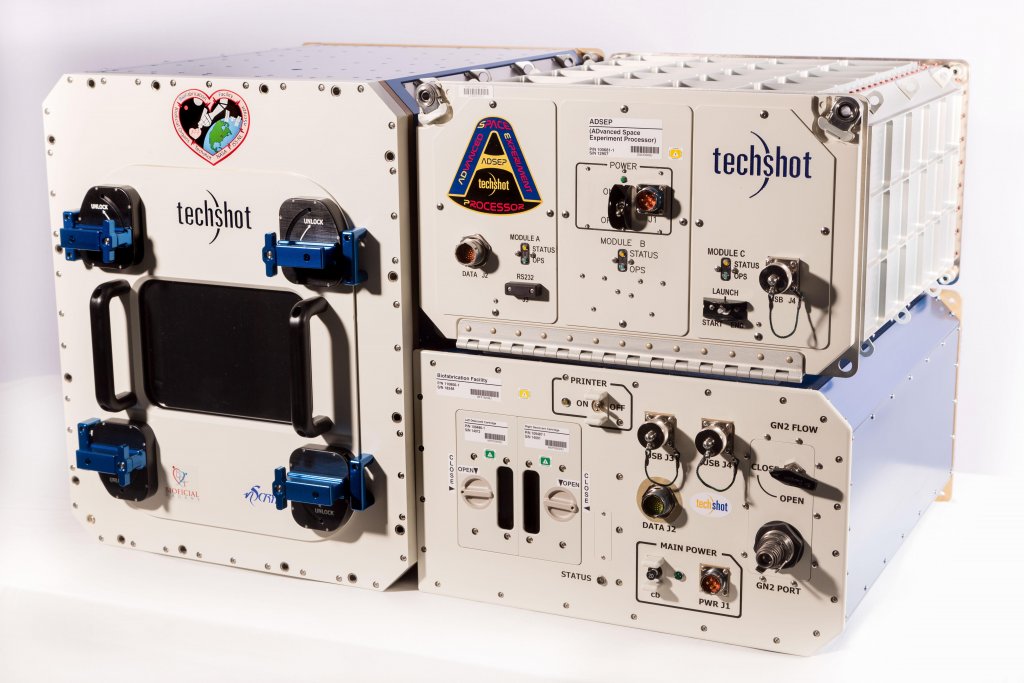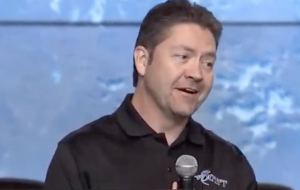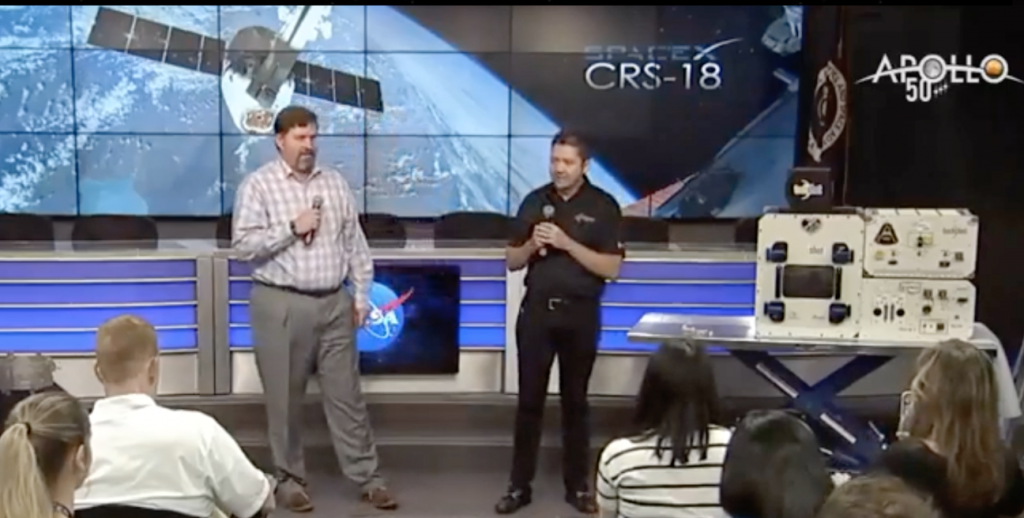The NASA BioFabrication Facility Launches Today: Will Use Microgravity to Grow Heart Tissue in Space
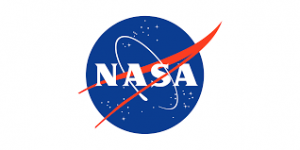 “We choose to go to the Moon!” We have heard that quite a lot over the last few weeks, along with celebrations in the United States and press coverage all over the world to commemorate a special day in peoples’ lives: when 50 years ago the Apollo 11 mission sent the first man to the Moon. But President John F. Kennedy’s famed tagline was delivered some seven years before that successful mission, seven years before Neil Armstrong put his left foot on the rocky Moon, proving that preparation and dedication can make all the difference for humankind. The same goes for other innovative fields, like bioprinting. If scientists are ever going to be able to develop functional organs, it might take time and a lot of work to get us there. Today many researchers are working with 3D bioprinters in an effort to manufacture human organs but they are meeting with some challenges. So, what if we take gravity out of the equation?
“We choose to go to the Moon!” We have heard that quite a lot over the last few weeks, along with celebrations in the United States and press coverage all over the world to commemorate a special day in peoples’ lives: when 50 years ago the Apollo 11 mission sent the first man to the Moon. But President John F. Kennedy’s famed tagline was delivered some seven years before that successful mission, seven years before Neil Armstrong put his left foot on the rocky Moon, proving that preparation and dedication can make all the difference for humankind. The same goes for other innovative fields, like bioprinting. If scientists are ever going to be able to develop functional organs, it might take time and a lot of work to get us there. Today many researchers are working with 3D bioprinters in an effort to manufacture human organs but they are meeting with some challenges. So, what if we take gravity out of the equation?
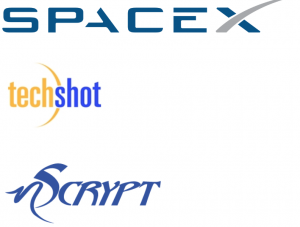 With NASA commercial cargo provider SpaceX launching its 18th resupply mission to the International Space Station (ISS) today, there have been quite a few prelaunch activities. On Tuesday, Gene Boland, chief scientist at Techshot, and Ken Church, chief executive officer at nScrypt, discussed the BioFabrication Facility (BFF), which is designed to print organ-like tissues in microgravity and will be part of the 5,000 pounds of cargo headed to the ISS this week. Space X’s Dragon spacecraft will be filled with supplies for the astronauts as well as payloads including critical materials that will support dozens of the more than 250 ongoing science and research investigations that will be conducted during Expedition 60 and beyond. Some of them will have a direct impact on people’s lives here on Earth, while others will support NASA’s Moon to Mars exploration plans.
With NASA commercial cargo provider SpaceX launching its 18th resupply mission to the International Space Station (ISS) today, there have been quite a few prelaunch activities. On Tuesday, Gene Boland, chief scientist at Techshot, and Ken Church, chief executive officer at nScrypt, discussed the BioFabrication Facility (BFF), which is designed to print organ-like tissues in microgravity and will be part of the 5,000 pounds of cargo headed to the ISS this week. Space X’s Dragon spacecraft will be filled with supplies for the astronauts as well as payloads including critical materials that will support dozens of the more than 250 ongoing science and research investigations that will be conducted during Expedition 60 and beyond. Some of them will have a direct impact on people’s lives here on Earth, while others will support NASA’s Moon to Mars exploration plans.
“We plan to use the BFF in orbit to print cells (extracellular matrices), grow them and have them mature enough so that when they return to Earth we can encounter a close to full cardiac strength. A tissue of this size has never been grown here, let alone in microgravity, so when we meet up again in about 45 days, we’ll let you know what happened,” said Church at a ‘NASA Social, What’s on Board’ science briefing from the agency’s Kennedy Space Center in Port Canaveral, Florida, where many of the prelaunch activities took place.
The BFF is a stepping stone in a long-term plan to manufacture whole human organs in space using refined biological 3D printing techniques. So, how does it work? Microgravity provides a potential third solution to printing complex organ structures, as minimal gravity removes the need for scaffolding structures to support complex tissue shapes. The BFF has three separate modules: the printing of cells takes place on the left side of the machine, while the top piece is a separate unit where the printed material is incubated. It is used in conjunction with existing Techshot bioreactor cassettes, which hold the printed tissues for several weeks after initial printing, allowing the tissues to cohesively form on a cellular level. During this incubation period, the cassettes are housed inside the Techshot Advanced Space Experiment Processor (ADSEP). Finally, it’s the maturation process that turns a construct into a tissue.
“We know SpaceX has a great launch and return vehicle but unfortunately its not a soft return vehicle, so what we have to do is incubate the cells for a while in space. This means that we are going to condition the printed biomaterial chemically, mechanically and electrically. These three signals will turn a bioprinting construct into a tissue, because what comes out of a bioprinter isn’t a tissue, it never will be a tissue, it will only be a construct because we are just putting building blocks down and then we need to step back and let biology do what it does,” explained Boland.
“As smart as we think we are, biology will always be smarter. And that is what our bioreactor will do, place those cues in where and when they are needed and for long enough so that we can bring the tissues back to Earth and observe what happens. Our goal is to obtain a tissue that is more than one centimeter thick (that’s more than 10 times what we can print on the ground today) and we consider that microgravity is going to be the key in building it without having to use an external structure,” he continued.
Church claims that they are hoping that a beating cardiac tissue will return to Earth from the BFF in space. But why cardiac tissue and not muscle tissue? According to the experts, the heart is “a fairly simple pump” and most of Boland’s team has a cardiovascular background, so it was a natural progression for them to work with this specific tissue type.
“Eventually we think we are going to print a heart, that’s really where we are going. But the equipment is really prepared to deal with tissue in general, so if you are doing tissue engineering experiments and want to try them out in space, welcome your new BFF!” said Church.
The BFF is taking a one-way trip to space for quite a while. The first cassettes (which hold the printed tissues for several weeks after initial printing) will return to Earth on the SpaceX 18th, which means sometime in late August. After that, the scientists will keep them in the lab and do mechanical and chemical testing, as well as analyze how the tissue compares to native tissue grown on the ground. Both experts suggested that there have been a lot of experiments with stem cells in space in the past, and mostly stem cells don’t behave as they do on Earth.
“We want to know if we can force the cells to do what we want them to in our bioreactors. We believe that we will be able to, but until they are back in the lab, we won’t know. We do have feedback and sensors in our system so we’ll know what they are doing up there but until we get them back in our hands we won’t know for sure,” continued Boland.
SpaceX’s Dragon spacecraft gets the science up to the ISS and brings the experimental samples back home for analysis. According to NASA, one of the next highlights is that the ISS is open for commercial business. Traditionally, the ISS Multidisciplinary laboratory focused on research, but there is a great interest in commercial use of the space station, and the use of space in general, which is why the agency has taken big steps to set up a policy for commercial use of the ISS, which includes how NASA astronauts can be involved, as well as pricing and allocation. Pete Hasbrook, manager of NASA’s International Space Station Program Science Office, said on Tuesday that there is an opportunity for destinations in Low Earth Orbit (LEO), for a module to be attached to ISS, as well as free-flying modules, private astronauts, manufacturing in space, new facilities, laboratory development, and even NASA’s long term needs for LEO. The ISS is a big supporter of exploration development, primarily in human research and technology, proving that there is a lot of room for 3D printing efforts to grow in space.
Ken Shields, chief operating officer of the ISS US National Laboratory, also discussed the lab’s work in advancing science in space and developing partnerships that drive industrialization.
“Business is booming on the ISS and the National Lab in particular, 70 percent of the payloads launched to ISS with SpaceX 18 come from the private sector. Which means that we are seeing a lot of positive trends, as it relates to research and development on the station which will always have a home with the ISS National Laboratory as it brings about benefits to humankind. This particular mission is a great representation of the trends that we are seeing, especially the diversity of applications in microgravity,” Shields suggested.
Dragon’s unpressurized trunk will take research to orbit, docking to the space station on Friday, July 26th, and greeted by NASA astronauts Nick Hague, Christina Koch, and Andrew Morgan. The ISS is a great place to start and foster activity and incubate it (like with the BFF), driving research in space to new heights.
You can tune in to hear about some of the amazing projects in science flying to the ISS aboard SpaceX’s 18th resupply mission to the orbiting lab and witness the launch at the following link: https://nasa.gov/live. And don’t forget to ask questions of some of the experts, available with #AskNASA. Date and time subject to change by NASA and the SpaceX team.
[Images: NASA, nScrypt, and Techshot]Subscribe to Our Email Newsletter
Stay up-to-date on all the latest news from the 3D printing industry and receive information and offers from third party vendors.
You May Also Like
3D Printed Heat Spreader Could Improve Efficiency of Electronics
The low-hanging fruit for decarbonization has long been improving the efficiency of existing systems, hence the justification for LED lights and ENERGY STAR certified appliances. While such minor moves are...
3D Printing News Unpeeled: Marine Gearboxes, 3D Printed Motors and $1.7 Million in Seed Funding
UK based Equipmake just released their Ampere-220 e-axle system. The system, which is meant for high performance electric cars, was similar to one released on the Ariel HIPERCAR. It has...
CEAD Unveils 36-Meter-Long 3D Printer for Abu Dhabi’s Al Seer Marine
CEAD, a Dutch original equipment manufacturer dedicated to large-format 3D printers, has unveiled what it claims to be the world’s largest robotic arm-based 3D printer. At 36 meters long and...
3D Printed Biocomposites Could Help Reduce Marine Plastic Pollution
Concerns about the impact of plastic litter and microplastics in the oceans are at the forefront of environmental study. For decades, the marine environment has suffered from the degradation of...


